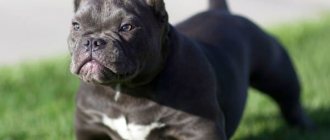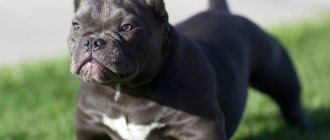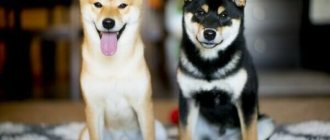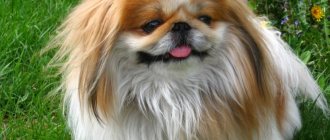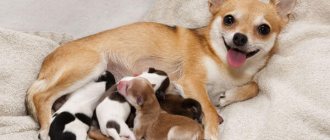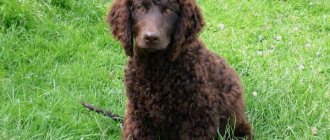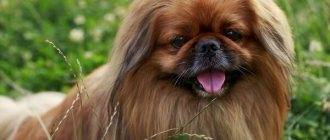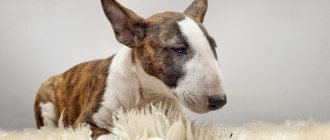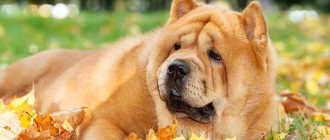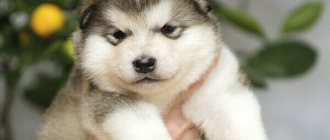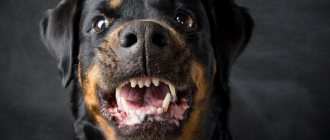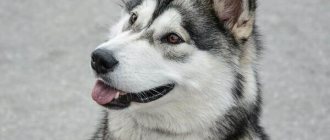The history of the Malamute originates from the Eskimo tribe Malemute, from which the name of the breed comes. Initially, dogs were bred for hunting and as sled dogs for carrying heavy loads.
It is believed that the distant ancestors of Malamutes are domesticated wolves from Central and East Asia, who came to North America with nomads from Eastern Siberia.
Research by scientists has shown that the wolf gene is indeed present in the DNA of these dogs.
The Chinese line of Malamutes appeared relatively recently. There is a version that she comes from one of the provinces near Mount Kunlun, which is located near the Tibetan border.
Enterprising Asian breeders tried to breed a giant dog by interbreeding a Malamute with a Tibetan mastiff.
The result was a beautiful and stately dog with characteristics of both breeds.
However, breeding of this line was prohibited due to frequent health problems with the dog. The weight and height of the animal put pressure on the fragile body, which caused problems with the heart, spine and joints.
It is still possible to purchase Malamutes of the Chinese line on the black market, despite the breeding ban.
Breed traits
Breed traits (on a 5-point scale)
| Alaskan Malamute | |||
| Activity | in the house | 2.4 | |
| on the street | 4 | ||
| Obedience | training | 2.8 | |
| strangers | 3 | ||
| Domination | in family | 2.2 | |
| over dogs | 3.8 | ||
| Defending your territory | from people | 1.8 | |
| from dogs | 4.2 | ||
| Sociability | in family | 4.8 | |
| with strangers | 3.6 | ||
| with dogs | 2 | ||
| Concentration | in family | 1 | |
| in front of strangers | 1.4 | ||
| with dogs | 2.2 | ||
| Aggressiveness | in family | 1 | |
| to strangers | 1.4 | ||
| to the dogs | 3.2 | ||
| to cats | 3.6 | ||
| Family behavior | calmness | 3.6 | |
| demand for affection | 4.6 | ||
| excitability | 3.6 | ||
| playfulness | 3.2 | ||
| excessive barking | 1.8 | ||
| behavioral breakdowns | 2.4 | ||
| Tolerance for children | up to 4 years | 3.4 | |
| over 4 years old | 3.6 | ||
| Institutional use | watchman | 3 | |
| bodyguard | 1.4 | ||
This breed is often compared to the following dog breeds: Samoyed, Akita Inu, German Shepherd, Siberian Husky, Labrador Retriever.
Photos of Malamute dogs:
Malamute muzzle
Rest on benches
Alaskan Malamute
General characteristics of the breed
The Alaskan Malamute is descended from a wolf. This is the oldest aboriginal breed, which has long lived next to humans. This large dog, even a giant, is very kind and affectionate in character. Due to his large height and powerful physique, he seems dangerous, but in fact he is not at all aggressive. Outwardly, Malamutes are similar to huskies, but they have a more independent and independent character.
This is an ideal working dog, very hardy and strong. But these dogs love people very much and trust them, so they are not suitable for the role of a guard. They are kind and friendly, do not show aggression, and are not capable of biting. This dog will take care of and accompany his beloved owner everywhere. He will become a devoted friend, a faithful companion, and a child's playmate.
| Options | Characteristic |
| breed name | Alaskan Malamute |
| country of origin | USA |
| group of breeds under the ICF classification | Spitz and primitive type breeds, northern sled dog section |
| year of breed registration | 1935, standard adopted in 1963 |
| height | males: 63-64 cm, females: 58-59 cm |
| weight | males: 36-43 kg, females: 32-38 kg |
| life expectancy | 13-16 years old |
| working qualities | hunting, sledding, companions |
| attitude towards a person | friendly, love all people, but tend to dominate |
| need for communication | their purpose is to serve people; they cannot stand loneliness |
| aggressiveness | not aggressive |
| training | difficult, you need to gain authority |
| health | strong, unpretentious, live long |
| need for care | difficult to care for, they shed a lot |
| activity | very active, playful, efficient, love to dig |
| noise | do not bark, can howl, make sounds similar to meowing |
pros
The Alaskan Malamute is an ideal pet for athletes and outdoor enthusiasts. He can become a faithful companion, playmate and travel assistant. Representatives of this breed have many advantages:
- very hardy, efficient, can withstand high physical loads;
- friendly, sociable, affectionate, very devoted to the owner;
- have an attractive, luxurious appearance;
- get along well with children, will never bite them, can become a nanny;
- not aggressive, kind, love all people;
- get along with dogs, cats and other pets;
- have good health, can withstand low temperatures, can be kept outdoors;
- smart, quick-witted, easy to train with the right approach;
- playful, cheerful.
Cons of the breed
The Alaskan Malamute is a good-natured and devoted companion, but quite difficult to keep and train. Due to his high intelligence and independent nature, this dog is difficult to train. It is not suitable for inexperienced owners, weak ones who cannot become a leader. People who are rarely at home and cannot pay much attention to their pet should not get one.
These dogs have several other disadvantages:
- due to its size it is difficult to keep in a city apartment;
- cannot tolerate hot weather;
- out of boredom and loneliness they can cause great damage to household property and howl loudly;
- require a lot of attention, can be intrusive, and are not suitable for keeping on a chain;
- Sheds a lot and is difficult to care for;
- stubborn, strive to dominate, can make independent decisions;
- high physical activity is required, intensive training is required;
- they love to dig, they are able to dig up the entire garden, dig under the fence and even ruin the floor in the house;
- They do not have watchdog and protective qualities, as they love all people.
In the video you can learn about the pros and cons of Malamutes:
Video: Pros and cons of the breed
Video: Alaskan Malamute pros and cons of the breed
Interesting facts about Alaskan Malamute dogs
Malamutes have been living next to humans for a long time. Since the time the breed became known in the world, it has not lost popularity. A lot of interesting facts about these dogs have accumulated:
- they are so strong and durable that they can pull a load of up to 1.5 tons;
- these dogs became a symbol of Alaska in 2010;
- shedding continues throughout the year, they shed their fur especially heavily in spring and autumn;
- representatives of this breed hardly bark, they communicate by howling, like wolves;
- They cannot stand loneliness at all, and with a lack of attention they become uncontrollable;
- suitable for harness racing, skijoring, canne-cross, Frisbee;
- thanks to endurance, love for people and the ability to make independent decisions, they can become good rescuers;
- Malamutes are big fans of digging, which can cause a lot of problems when kept on the property;
- these dogs are so similar to wolves that they are often played in films;
- In America, a dog of this breed was used to train artificial intelligence to think like a dog.
Interesting photos of Alaskan Malamutes:
Alaskan Malamute mouth
Walking with a child
Alaskan Malamutes in harness
Huge Malamute
Price range
Before the ban on breeding Chinese Malamutes was introduced, the dogs had the highest price . The price for a puppy reached 200 thousand rubles.
Malamutes of the Chinese line are very beautiful and intelligent dogs. They get along easily with humans, children and other animals.
Suitable for outdoor use . However, an inexperienced breeder should hold off on purchasing a puppy of this breed.
History of the origin of the Alaskan Malamute breed
Alaskan dogs are representatives of the oldest indigenous breeds in North America. Excavations have proven that they lived next to humans 3 thousand years ago. It is believed that modern northern giants are descendants of domesticated wolves. And genetic studies conducted at the beginning of the 21st century proved that they have hardly changed since ancient times. Their relationship with Siberian huskies was also revealed. This proves that these dogs came to the American continent along with man from East Asia through the Bering Strait.
The Alaskan Malamute got its name from the Eskimo Malemiut tribe. It was previously the most numerous and lived in the coastal areas of Alaska. These dogs were irreplaceable helpers for humans. They carried loads, helped hunt, protected from predators, and warmed children with their bodies.
They were not specially bred, but the strongest survived in harsh climatic conditions. The dogs had to withstand cold and hunger, and carry heavy loads. Therefore, they were giants with a powerful physique, thick hair, hardy and strong. For the Malemiuts, they became family members and often saved their owners. The dogs were peaceful, hardworking, smart.
Old photographs are interesting, which show that the appearance of the breed has not changed much:
Old photo of Malamute
The appearance has not changed since then
Historical photo
They became known to other nations at the end of the 19th century. This was the time of the gold rush, when many Europeans came to America. They brought their sled dogs with them, but Malamutes were especially adapted to the harsh conditions. The breed became very popular, they were bought at a high price.
But people sought to get an even more durable and fast dog. Therefore, they began to cross Malamutes with other dogs. Because of this, the breed was in danger of extinction. Only through the efforts of enthusiasts were purebred representatives preserved. At the beginning of the 20th century, there were two breeding lines: Kotzebue and M'Loot.
The first variety was bred in New Hampshire from individuals brought from the Norton area. Kotzebues were less aggressive and smaller. They have retained their original wolf coloring. M'Loot are larger, stronger dogs. They had different colors. From these two lines the modern Malamutes originated. Although now it is impossible to determine their variety, since they are mixed.
Officially as a breed, Alaskan Malamutes were recognized in 1935. But during the Second World War they almost disappeared again. Due to their intelligence and working qualities, Malamutes were often used for military purposes in the North. And by the end of the 40s, only a few dozen individuals remained. But gradually the breed's numbers were restored.
By 1963, a single standard was approved. These dogs have retained the appearance and habits of their ancient ancestors. Now Malamutes are one of the most popular breeds and the official symbol of Alaska. They appeared in Russia only in the mid-90s. There are several regional varieties: Siberian, Altai, Yakut, Valdai. Outwardly, it is almost impossible to distinguish them from the original representatives of the breed. The difference is noticeable in character, habits and working qualities. But the purebred Alaskan Malamute is also popular in Russia.
The pictures show the working qualities of these dogs:
In harness
Sled in the snow
Participate in races
Useful video
From the video you will learn everything about the Malamute dog breed:
Hello, dear readers!
This is a large native dog breed. Used for sled riding and cargo transportation. It got its name from the Malemute tribe of Eskimos living in Alaska, who developed it. The breed turned out to be in great demand during the exploration of Alaska and during the “gold rush”. During the war of 1941, these animals were used for military service, as a result of which they were practically exterminated. The surviving purebred individuals were bred. By the mid-20th century, the Malamute population was revived and increased in number. In 2010, the Alaskan Malamute was awarded the status of a symbol of Alaska.
Description of the appearance of Malamute dogs
This is a large sized dog. According to the standard, the height of Malamutes reaches 64 cm. Due to their powerful build and fluffy fur, they appear even larger. The average weight of a Malamute is 38-40 kg, but can reach up to 50 kg. The skeleton is large, the muscles are developed, so the dog looks impressive and menacing.
The main features of appearance are a strong build, muscular paws, a large head, a wide chest and thick fur. From the outside, Malamutes are very similar to wolves. This is a beautiful, harmoniously built dog.
The pictures show what Malamutes look like:
Appearance
Appearance
Head
The Malamute's head is large, wide, and proportional in size to the body. Between the ears the skull is rounded, gradually tapering towards the eyes. The stop is clearly defined, the muzzle is large, not narrow. The jaws are powerful and have a scissor bite. The lips are close-fitting and black. The eyes are almond-shaped and medium in size. Set wide, slightly askew. Their color is dark or amber. The look is good-natured, smart. Blue eyes are not allowed by the standard.
The nose is large and black. In winter, pigmentation may be weaker. The ears are triangular in shape, rounded at the ends, and medium in size. Planted far from the eyes. The ears are erect, very mobile, their position depends on the dog’s mood. When the Malamute pulls the load, it lays them back.
Body type
The physique is harmonious and powerful. Wide bones and strong muscles make this dog hardy and efficient. The body is almost square in format, compact, but the length is slightly greater than the height at the withers.
The neck is muscular and wide. The back is straight, the lower back is muscular. The stomach is not tucked. The tail is covered with thick hair. The dog holds it raised above his back, but does not twist it into a ring.
Limbs
The limbs of this dog are muscular, straight, parallel. The hock joints are weakly defined and located low. The movements are powerful, smooth and confident. The paws are adapted for walking in deep snow. The pads are well developed, the claws are long and retractable, like those of a cat. The fingers are tightly closed, there is a lot of wool between them. Therefore, the dog does not fall into the snow and does not slide on the ice.
Coat and colors
The Malamute has a double coat. The top layer of wool is hard. It is longer on the neck, shoulders, hips, back and tail. The undercoat is thick, dense and soft. This cover protects the dog from frost and moisture. In summer, the coat becomes shorter and thinner.
The most common color is wolf. Sometimes sable is found. Nowadays pure white Malamutes are also common. But usually several colors are combined. White on the belly, paws, and in the form of a mask on the face. Spots are allowed only on the head; the coloring on the body is uniform.
Photos of Malamutes of different colors:
Sable color
Wolf color
Sable color
Varieties
Now two lines of the breed are no longer distinguished: Kotzebue and M'Loot. Although there are slight differences between them. Kotzebues are smaller and good-natured. They are more suitable as a companion and pet. M'Loot - large, hardy, can be aggressive. They are more often used as workers and guards.
When the breed became popular throughout the world, breeding work began in different regions. Malamutes are not crossed with other breeds, but individuals with the desired qualities are left for breeding. This is how several regional varieties appeared that look the same, but there are slight differences:
- American;
- English;
- Canadian;
- Siberian;
- Tibetan;
- Alpine;
- Japanese;
- Chinese;
- Yakut.
Photos of breed varieties:
Differences from similar breeds
Most often, Malamutes are confused with Huskies; these are also northern sled dogs; they have common roots. But they belong to different breeds, differ not only in appearance, but also in habits. The main difference: the Malamute is larger, more durable, and can carry heavy objects. He has more weight, wider bones, and thicker fur.
Huskies are faster, but not as durable. They have a graceful build, a narrower muzzle, and ears set close together. Sometimes they are distinguished by their eyes: in huskies they can be blue, which is not allowed in malamutes.
Related breeds also include the Alaskan Klee Kai, Czechoslovakian Wolfdog, Northern Inuit, Saarloos Wolfdog, and Utanagan. Malamutes are sometimes called huskies, but this is incorrect. These breeds are very different from each other. Laikas are smaller hunting dogs. They cannot be used for transporting goods. The husky has long legs, a narrow elongated muzzle, and a tail curled into a donut.
The pictures show the differences between similar breeds:
Difference between Husky and Alaskan Malamute
Malamute and husky
Malamute on the left, husky on the right
Yakut Laika
Types of colors
The options for Malamute coat colors are amazing in their diversity. Basically, this is a combination of white and other shades, making each individual individual.
The monochromatic coat color of representatives of this breed can only be white .
Black and white
The awn is black, the undercoat is black or dark gray. The Seal and White color can also be included in this category - in such dogs the guard hairs are completely black or only at the tips, and the undercoat is white or cream-colored.
Puppies of these colors have almost the same color at birth; it is almost impossible to predict what the adult will be like.
Gray with white
The guard hairs are gray, and the undercoat is white, cream or light gray. Any inclusions of a reddish tint are unacceptable.
Although there may be darker or black hairs along the topline, Malamutes with this coloration give the impression of a gray dog.
Sable with white
The awn is black or gray, the undercoat has a reddish tint. Visually, shades of both black and red are clearly visible.
Silver with white
In such dogs, the guard hair is pigmented with a light gray color, and the undercoat is white.
Gray-white, silver-white and sable-white colors can be classified as one color group, which most people mistakenly consider to be the only correct one for this breed.
Red with white
The awn is colored in any shade of red: from rich brown to golden yellow. Black color is not acceptable.
Blue and white
Blue color is formed as a result of genetic dilution of black. Blue and white Malamutes have blue rings on the guard hairs, and the undercoat is dark gray or blue.
Solid white
These Malamutes have a snow-white coat and the same undercoat. Some individuals have a less pronounced creamy mask. They can only be born as a result of the mating of two white individuals.
Character of Malamutes
Alaskan Malamutes perceive everyone around them as their pack. They need to be constantly surrounded by people. They are friendly with everyone, affectionate and welcoming. They greet guests with joy and try to please them. These are not monogamous people; they easily get used to a new owner. But they constantly need attention.
The Malamute is a dog that remains a puppy until it is 3 years old. She is active, cheerful and playful. Irrepressible energy requires an outlet, so the dog never sits still and constantly demands attention. But even as an adult, he does not tolerate a sedentary lifestyle. He needs long walks, jogging, and intense exercise.
Malamutes get along well with children and can become a caring nanny and playmate. But it is not recommended to leave him alone with children. The dog will not deliberately harm the child, but since he strives to dominate and is quite large in size, he may accidentally injure him.
For the same reason, it is undesirable to keep him in the same house with small dogs, cats, and even more so rodents and birds. Malamutes have a desire to be superior to others and to command. And he can hunt small animals. Only with proper upbringing and early socialization can this dog get along with other pets.
Malamutes are not suitable for the role of guard and watchman. These are good-natured dogs, they do not bite. Moreover, they do not know how to bark, but only howl.
The photo shows the behavioral features of adult Malamutes:
With baby
With a girl
In the forest
Don't be sad…
Education and training
Malamutes are strong and independent, so it is very important to pay a lot of attention to their proper upbringing. These are smart, quick-witted dogs, they have a good memory and the ability to make decisions independently. It is very difficult to train them. To do this, you need to immediately gain authority, show firmness and perseverance. This dog will constantly strive to dominate and test all family members.
You need to raise a puppy from an early age. In order for him to immediately feel who is boss in the house, you need to follow several rules:
- the people eat first, and then the dog;
- the dog comes through the door and goes up the stairs after the man;
- should not be allowed to sleep on the bed;
- You need to pet the dog while eating;
- do not feed from the table;
- A dog should not win games or take away toys from a person.
You can independently teach your puppy to respond to a nickname, to be calm towards cars, sharp sounds, and other animals. From an early age you need to learn the basic commands: “place”, “to me”, “no”, “fu”, “near”, “sit”, “stand”.
Classes should be carried out in a playful way; Malamutes quickly lose interest in monotonous training. You cannot shout, show aggression or hit this dog. It is important to find a common language with your pet and reward it more often for success. From 4 months, it is advisable to visit the dog playground and complete a general training course.
An interesting video about the character and upbringing of these dogs:
Video: Training
Nutrition
Large and playful dogs need a lot of calories. The foods they eat daily should contain large amounts of carbohydrates. They also need all the useful microelements, vitamins, as well as protein and fats.
An Alaskan Malamute puppy can eat raw meat, grains and dairy products. In this case, you should alternate dishes for him. For example, in the first half of the day give cottage cheese, chicken and milk, and in the second - cheese and porridge.
A more suitable food product for young and mature huskies is dry or wet food. We recommend choosing an alternative method of feeding such pets and combining it. More details: mix 300 grams of dry food with whey or fresh milk (you can also add freshly brewed buckwheat or rice to the mixture).
If the mixture is hot, cool it. Dogs love this dish. But for them it is not just tasty, but also very healthy. Such food will charge them with energy for a long time, strengthen their immune system and provide them with all the necessary vitamins. Also, during the cold season (winter), do not forget to treat your dog with vegetables and fruits so that he receives microelements all year round. For example, you can give him:
- Carrot.
- Apples.
- Bananas.
- Citruses.
- Potatoes (boiled).
Keeping adult Malamute dogs
An Alaskan Malamute will not make a cute pet. He does not tolerate loneliness or closed spaces. At home, these dogs amuse themselves by running around rooms, gnawing and destroying everything. They also cannot be kept on a chain; a dog deprived of its freedom can become aggressive and uncontrollable.
Therefore, before purchasing a puppy of this breed, you need to consider whether there are conditions for keeping it. A spacious enclosure with a warm booth is best suited for this. It is advisable to place a deep box of sand there for the dog to dig. Malamutes are often called “diggers”; you can recognize the yard in which this dog lives by its deep holes.
Features of care
It is difficult to care for the fur. It is thick, dense, and needs to be combed several times a week. During shedding - twice a day, otherwise the whole house will be covered with hair, and tangles will appear on the dog's body. It is better to comb out with a brush with stiff bristles; you may also need a slicker brush.
Regular care of your pet's eyes and ears, brushing of teeth and trimming of nails is also required. It is not recommended to bathe Malamutes often; 3-4 times a year is enough. They are clean and lick themselves. Show dogs, especially those with white fur, are bathed more often. In summer, you can give them water treatments in open reservoirs.
Health
These dogs have good health, they are hardy and unpretentious. They are long-lived, many representatives of the breed live up to 15-16 years. They can withstand low temperatures, heavy physical activity and even fasting. But they are also susceptible to some diseases:
- polyneuropathy;
- neurological disorders;
- diabetes;
- hip dysplasia;
- cataract, glaucoma.
It is also necessary to regularly receive all necessary vaccinations to protect your pet from infections. And because of the thick, long hair, it is important to treat it from parasites in a timely manner.
Nutrition
Malamutes are unpretentious eaters and are very gluttonous. They will eat even if they are not hungry. Therefore, it is important to develop a clear feeding regimen and monitor portion size. An adult dog should eat 1-2 times a day, at the same time. You cannot give a large portion at a time; these dogs are prone to volvulus.
You can feed them natural food or dry food of at least premium class. The main diet consists of porridge cooked in broth. They add meat, offal, and vegetables. You should not give bones, sausages, smoked meats, fatty and fried foods, and sweets. Unsalted crackers are suitable as a treat. You can choose any dry food designed for large dogs.
Life expectancy and health
Malamutes from the Chinese breeding line live 10-12 years with proper care and nutrition . However, due to a genetic predisposition to diseases of the joints and heart, few dogs live to this age.
Chinese Malamutes are susceptible to the following diseases:
- dysplasia of the hip and elbow joints;
- ear infections;
- heart diseases;
- osteochondrosis;
- diabetes;
- eye diseases;
- skin diseases.
How to buy an Alaskan Malamute puppy
You need to purchase a puppy from well-known nurseries or from reputable breeders. A purebred dog will definitely have documents from the RKF or the Union of Cynological Organizations of Russia. You need to check that you have a veterinary passport with all the vaccinations required by age.
Little Malamutes are funny little bumpkins. But you need to choose a healthy puppy. He should be cheerful, playful, not cowardly. The coat is without bald spots, fluffy, without an unpleasant odor, the eyes and ears are clean.
You can buy a purebred Malamute in Moscow for a price ranging from 40 to 120 thousand rubles. The cost depends on the pedigree and breed qualities. An adult exhibition winner can cost up to 500 thousand rubles. You can buy a pet for yourself that will not participate in exhibitions and breeding for 20-30 thousand.
The photo shows what Malamute puppies should look like:
To decide whether to get a dog of this breed, you can watch the video:
Video: Malamute in the countryside: is it worth getting and what to expect
Video: Alaskan Malamute - myths and reality!
Alaskan Malamutes are beautiful, strong and kind dogs. They have many positive qualities, but it is not recommended to have such a dog for elderly people, homebodies or those who are at work all day. The Malamute requires constant communication and physical activity. Without this, he may get sick and become aggressive and disobedient. But this is an ideal companion for families with children, sports lovers, and active young people.
Pet care
The breed requires a lot of attention when caring for it . You should not get a dog if you cannot pay due attention to its appearance and health.
The condition of Malamutes' ears is checked every day . Clean with a swab soaked in a special lotion every week. If you notice an unpleasant odor or any discharge, you should contact your veterinarian.
Claws
If the claws do not grind down naturally, then use a special metal nail clipper. The haircut procedure is carried out as needed.
Eyes and teeth
Eyes are examined every day . If necessary, wipe with chamomile decoction. This usually happens 5-6 times a month.
Teeth are also examined daily . Clean once a week using special pastes to prevent plaque and tartar formation.
Wool
Special attention is paid to wool. The breed is quite clean and there is often no “dog” smell. However, this does not exempt them from bathing.
Dogs are not washed often - once every 2-3 months . But they must be combed once a week, and even every day during the molting period. Long, thick hair without proper care will roll up and turn into tangles.
